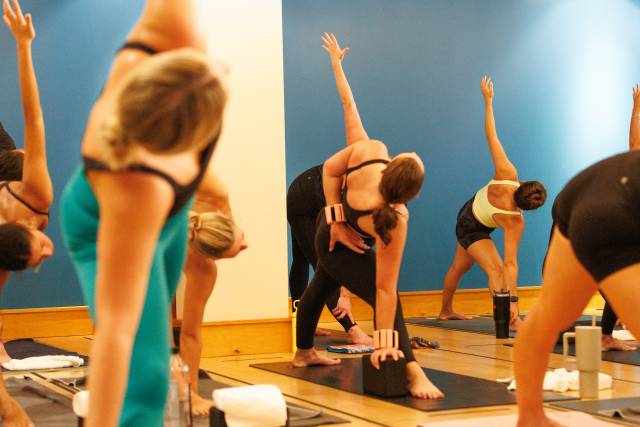Yoga Nidra is perhaps the ultimate yogic mindfulness practice for deep relaxation. In our fast-paced, stress-filled world, finding moments of true relaxation can feel like searching for a needle in a haystack. But what if there was a practice that could transport you to a state of deep calm, leaving you feeling refreshed and rejuvenated? This powerful technique has been gaining popularity among yoga enthusiasts and stressed-out individuals alike, and for good reason. In today’s post, we are going to spend a few minutes exploring the ins and outs of Yoga Nidra, its benefits, and how you can incorporate it into your life for maximum relaxation and mindfulness.
What Exactly is Yoga Nidra?
Yoga Nidra, often referred to as “yogic sleep,” is a state of consciousness between waking and sleeping. It’s a systematic method of inducing complete physical, mental, and emotional relaxation. The term “Nidra” means sleep in Sanskrit, but it’s not about falling asleep in the traditional sense. Instead, it’s about reaching a state of deep relaxation while maintaining awareness.
During a Yoga Nidra session, you lie down in a comfortable position (usually Savasana or corpse pose) and are guided through a series of instructions. These instructions lead you through various stages of relaxation, including:
- Setting an intention (Sankalpa)
- Body scan and relaxation
- Breath awareness
- Observing thoughts and emotions
- Visualization exercises
- Returning to wakefulness
The beauty of Yoga Nidra lies in its simplicity. You don’t need to be flexible, strong, or even awake to practice it. All you need is the willingness to lie down, listen, and let go.
Far Reaching Benefits for Your Daily Life
The benefits of practicing Yoga Nidra are numerous and far-reaching. Here are some of the ways this powerful practice can improve your life:
- Stress Reduction – In today’s world, stress seems to be a constant companion. Yoga Nidra provides a much-needed respite from the daily grind. By activating the parasympathetic nervous system (your body’s “rest and digest” mode), it helps lower cortisol levels and reduces the physical and mental effects of anxiety, depression, and stress.
- Improved Sleep – If you struggle with insomnia or poor sleep quality, Yoga Nidra might be your new best friend. Regular practice can help reset your sleep patterns, making it easier to fall asleep and stay asleep throughout the night.
- Enhanced Mindfulness – Yoga Nidra is a form of guided meditation that cultivates mindfulness. As you practice, you learn to observe your thoughts and emotions without judgment, developing a greater sense of self-awareness and presence in your daily life.
- Emotional Healing – The deep relaxation induced by Yoga Nidra can help release stored emotions and tensions. Many practitioners report feeling emotionally lighter and more balanced after regular sessions.
- Increased Creativity – By accessing the subconscious mind, Yoga Nidra can unlock your creative potential. Many people find that solutions to problems or new ideas arise spontaneously during or after practice.
- Physical Healing – While Yoga Nidra isn’t a substitute for medical treatment, it can complement healing processes. The deep relaxation it induces can help reduce pain, lower blood pressure, and boost immune function.
Perfecting Your Yoga Practice
Now that you’re familiar with the benefits, you might be wondering how to get started with Yoga Nidra. Here’s a step-by-step guide to help you begin your practice:
-
Find a comfortable space: Choose a quiet, comfortable place where you won’t be disturbed. You can practice on a yoga mat, in bed, or even on the floor with a blanket.
-
Get cozy: Use blankets, pillows, or bolsters to make yourself as comfortable as possible. The goal is to be able to relax completely without any physical discomfort.
-
Set an intention: Before you begin, take a moment to set an intention or Sankalpa. This is a short, positive statement about something you want to manifest in your life.
-
Follow a guided practice: As a beginner, it’s best to follow a guided Yoga Nidra practice. You can find numerous recordings online or use a meditation app.
-
Stay awake (if you can): While it’s okay if you drift off to sleep, try to maintain a state of relaxed awareness throughout the practice.
-
Be consistent: Like any practice, the benefits of Yoga Nidra compound over time. Aim to practice regularly, even if it’s just for 10-15 minutes a day.
Incorporating Yoga Nidra into Your Life
One of the great things about Yoga Nidra is its flexibility. You can practice it at any time of day, although many people find it particularly beneficial before bed or as a midday reset. Here are some ways to incorporate Yoga Nidra into your daily routine:
- Morning practice: Start your day with a short Yoga Nidra session to set a calm and focused tone for the day ahead.
- Lunchtime reset: Use your lunch break to practice Yoga Nidra and return to work feeling refreshed and recharged.
- Evening wind-down: Practice Yoga Nidra before bed to release the tensions of the day and prepare for restful sleep.
- Weekend relaxation: Dedicate some time on the weekend for a longer Yoga Nidra session to deeply relax and recharge for the week ahead.
The Power of Regular Yoga Classes
While Yoga Nidra can be practiced on its own, it’s often incorporated into regular yoga classes. Participating in regular yoga classes can be incredibly beneficial in achieving your relaxation and mindfulness goals. Here’s why:
-
Expert guidance: Yoga instructors can provide personalized guidance and adjustments, helping you deepen your practice and avoid common mistakes.
-
Community support: Practicing in a group setting can be motivating and provide a sense of connection with like-minded individuals.
-
Structured practice: Regular classes provide a structured environment that can help you maintain consistency in your practice.
-
Holistic approach: Many yoga classes incorporate various elements of yoga, including asana (physical postures), pranayama (breathwork), and meditation, providing a well-rounded approach to mindfulness and relaxation.
-
Accountability: Committing to regular classes can help you stay accountable to your practice and goals.
By combining regular yoga classes with your at-home Yoga Nidra practice, you can create a powerful synergy that accelerates your progress towards deep relaxation and mindfulness.
A Journey of Deep Relaxation & Mindfulness
In a world that often feels overwhelming and chaotic, Yoga Nidra offers a sanctuary of peace and relaxation. By dedicating just a few minutes each day to this practice, you can tap into a wellspring of calm that will ripple through every aspect of your life.
Remember, the journey to deep relaxation and mindfulness is just that – a journey. Be patient with yourself as you explore Yoga Nidra. Some days, you might find it easy to sink into a state of relaxation, while other days, your mind might be more active. That’s perfectly normal and part of the process.
As you continue to practice, you’ll likely notice subtle shifts in your daily life. You might find yourself responding to stressful situations with more ease, sleeping more soundly, or simply feeling more present and alive in each moment. Sweet dreams and happy practicing!







